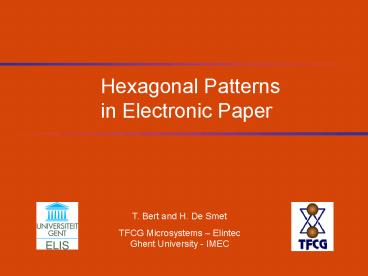Hexagonal Patterns in Electronic Paper PowerPoint PPT Presentation
1 / 15
Title: Hexagonal Patterns in Electronic Paper
1
Hexagonal Patterns in Electronic Paper
T. Bert and H. De Smet TFCG Microsystems
ElintecGhent University - IMEC
2
Overview
Introduction Pattern EHD Conclusion
Introduction ? what is electronic paper? ?
applications ? technology Pattern formation ?
properties ? conditions Electrohydrodynamics
? applications ? formulas
3
Electronic Paper
Introduction Pattern EHD Conclusion
Benefits lightweightflexibilitybistabilityreadi
bility
Drawbacks switching speedno threshold
(electronic inks)no (good) colourelectrochemical
complexity
4
Electronic Paper
Applications
Introduction Pattern EHD Conclusion
Bio-sensors
Smart Cards
E-Signs
E-Books
5
Electrophoretic Image Display
Introduction Pattern EHD Conclusion
6
Electrophoretic Image Display
Introduction Pattern EHD Conclusion
7
Pattern formation
Introduction Pattern EHD Conclusion
Excess amount of free chargeHigh applied voltage
8
Pattern formation
Introduction Pattern EHD Conclusion
Pattern properties ? Only for Vgt threshold value
10V? Hectic pigment movement stabilizes into
pattern? Time constant few seconds? Hexagon
Radius 600µ? Hexagon Radius independent of
V Bad optical properties ? electrode not
covered with pigment? net pigment movement is
slower
9
Electrohydrodynamics
Introduction Pattern EHD Conclusion
- electrodynamics of moving media? electric forces
on dielectric fluids - external force -
interparticle force
10
Electrohydrodynamics
Introduction Pattern EHD Conclusion
Hydrodynamics temperature difference
Electro-Hydrodynamics voltage difference
11
Electrohydrodynamics
Introduction Pattern EHD Conclusion
Pattern formation Driving force ?
temperature difference ? voltage difference
(VdI) gt Damping force ? friction ?
viscosity
Far from equilibrium system organizes in
spatial or temporal structure e.g. hexagonal
patterns
12
Electrohydrodynamics
Introduction Pattern EHD Conclusion
Parameters
13
Electrohydrodynamics
Introduction Pattern EHD Conclusion
Numerical values
When Cgtgt1 ? critical T-value 100
? critical V-value 10V
14
Conclusion
Introduction Pattern EHD Conclusion
Excess amount of charge
? Vcritical10V
? centrifugation and removal of micelles? Space
charge limit not reached? NO PATTERN
15
Introduction Pattern EHD Conclusion
Thank you Questions?

